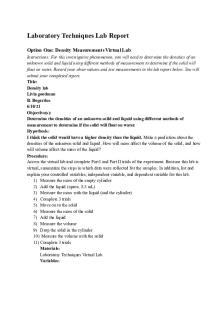Organic Chemistry Laboratory: Laboratory Techniques used (Study material for practical) PDF

| Title | Organic Chemistry Laboratory: Laboratory Techniques used (Study material for practical) |
|---|---|
| Course | (CHEM 2123, 2223, 2423) Organic Chemistry Laboratory |
| Institution | Texas A&M University |
| Pages | 2 |
| File Size | 74.5 KB |
| File Type | |
| Total Downloads | 60 |
| Total Views | 142 |
Summary
Lab Techniques used, study material for practical...
Description
Techniques:
Potassium Iodide- Starch Test: tests for oxidizing agents (bleach), a positive test = blue-black color. The oxidizer reacts with the starch and gives off the color when present. Silver Nitrate Test: tests for presence of alkyl halides. Put drops of the Silver Nitrate into a test tube of solution. o Alkyl Chlorides = white precipitate formed o Alkyl Bromides = light yellow precipitate formed o Alkyl Iodides = yellow precipitate formed Bromine Test: test for alkenes and alkynes. Add a few drops to the sample and the dark red color of bromine will disappear in the presence of alkenes or alkynes = + test. Can also test positive for ketones, aldehydes, amines, and phenols. Permanganate Test (Baeyer’s): tests for the presence of alkenes and alkynes. You will put in a few drops of the potassium permanganate and the purple will disappear and a brown precipitate will form meaning a (+) test. Superior to Bromine test, because the Permanganate can react with the alkenes that are not reactive enough in the bromine. Ferric Chloride Test: tests for presence of phenols. Add the FeCl3 and stir the mixture, a positive test will give a color of a red, green, or blue if it is positive for phenols. The color may linger or it may be fleeting. Thin Layer Chromatography (TLC): a silica gel plate, the solvent must be volatile, the sample will move up the plate as it dissolves and absorbs. Useful for detecting impurities. The speed of travel up the plate gives characteristic Rf values to compare and detect impurities. Column Chromatography: use a small glass pipet filled with silica gel. Used to separate organic mixtures by particle size, similar to TLC. The finished product ends at the bottom collected in a beaker. You can purify more sample rather than TLC. Gas Chromatography (GC): separation of a mixture by passing over an absorbent and separating the components by differential absorption and elution. The area of the peak is relative to the amount of the compound. It can separate mixtures with close boiling points. o Requirements: sample must be volatile, be dry (no water), and be thermally stable. Extraction: liquid-liquid extraction, both must be liquid, they must be immiscible, different affinities for material being isolated, must have different densities, and it must be possible for you to isolate the product from the extracted liquid. Use a sep funnel or a test tube (for micro extraction). Good for isolation and purification. Steam Distillation: using the steam from a steam bath to distill a solution. Used with high boiling point materials that may decompose at higher temperatures, distills materials at temperatures below their boiling point. Material to be isolated can be water-insoluble. Separate volatiles from non-volatiles and will remove water. Fractional Distillation: uses distillation equipment with ridges to increase surface area. The increased surface area allows for separation of the material if the BP are less than 20C and before 10C
Simple Distillation: process of purification by boiling a mixture and collecting the condensed vapors. The 2 liquids must be miscible. Have different BP, the lower BP on one condensing separate volatile liquids from non-volatile liquids. IR Spectra: to determine functional groups of a compound, shows vibrational frequencies (peaks) of bonds. Recrystallization: method to remove impurities from a sample. Favors high melting solids, and thermally unstable solids. The recrystallized product is pure. o 4 Points: Solvent should not chemically react with the compound. Solvent should not dissolve both solid compounds. Either dissolve the impurity completely or not at all. Solvent should dissolve the compound when hot. Solvent should not dissolve the compound when cooled. Solubility Test: Sodium Bicarbonate, a weak base, is added to a sample and with protic acids it will form a salt. Mixture Melting Point: will identify impurities, an impurity will cause the MP to lower and become broader. The lower end of the MP range is when the first drop of liquid is seen. A eutectic mixture has a sharp MP. Benzoic acid mixed with organic sand will not affect the temperature. Reflux Apparatus: to heat a reaction to boil and condensing the vapors. Distillation, to separate volatiles from non-volatiles....
Similar Free PDFs

Basic Laboratory Techniques
- 11 Pages

Laboratory Techniques Lab Report
- 4 Pages

Lab 1 - Laboratory Techniques
- 14 Pages

Laboratory Values for NCLEX
- 4 Pages
Popular Institutions
- Tinajero National High School - Annex
- Politeknik Caltex Riau
- Yokohama City University
- SGT University
- University of Al-Qadisiyah
- Divine Word College of Vigan
- Techniek College Rotterdam
- Universidade de Santiago
- Universiti Teknologi MARA Cawangan Johor Kampus Pasir Gudang
- Poltekkes Kemenkes Yogyakarta
- Baguio City National High School
- Colegio san marcos
- preparatoria uno
- Centro de Bachillerato Tecnológico Industrial y de Servicios No. 107
- Dalian Maritime University
- Quang Trung Secondary School
- Colegio Tecnológico en Informática
- Corporación Regional de Educación Superior
- Grupo CEDVA
- Dar Al Uloom University
- Centro de Estudios Preuniversitarios de la Universidad Nacional de Ingeniería
- 上智大学
- Aakash International School, Nuna Majara
- San Felipe Neri Catholic School
- Kang Chiao International School - New Taipei City
- Misamis Occidental National High School
- Institución Educativa Escuela Normal Juan Ladrilleros
- Kolehiyo ng Pantukan
- Batanes State College
- Instituto Continental
- Sekolah Menengah Kejuruan Kesehatan Kaltara (Tarakan)
- Colegio de La Inmaculada Concepcion - Cebu











